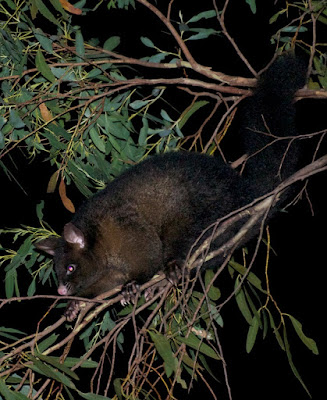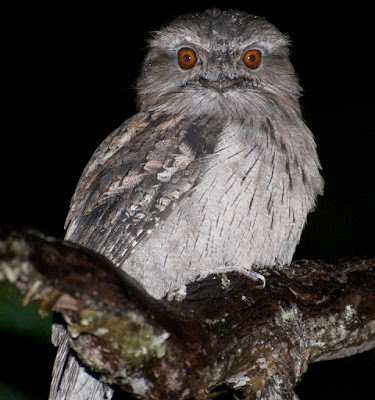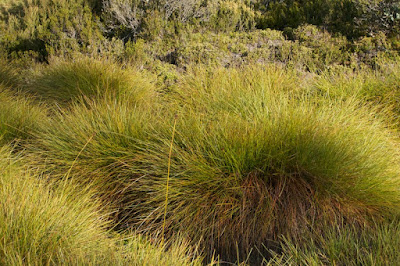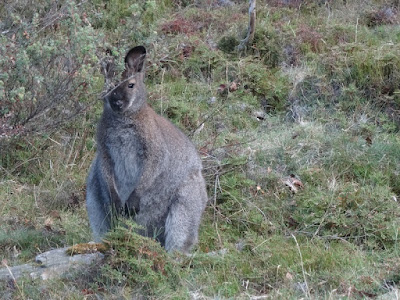After our long day at Cradle Mountain (March 26, 2014), sleep was certainly high on all our minds; but I couldn't resist taking Ryan on a brief night walk around our cabin site. We didn't find a great deal, but we did see some animals that we would have missed if we had gone to bed. Ryan was a bit nervous about the dark, but was game all the same.
We had already seen Tasmanian Padamelons (Thylogale billardierii) by day, but they were certainly more active after dark.
New for Ryan, though, were two Common Brushtail Possums (Trichosurus vulpecula) hissing at each other in a clump of eucalyptus trees (we heard them before we saw them). I have seen plenty of Brushtails in my time, but the rich color of these Tasmanian animals (subspecies fuliginosus) was a surprise to me.
Brushtails I have seen on the mainland (and in New Zealand, where they are an abundant human introduction) are, usually, mostly grey. They are, however, very variable, and the two we saw - one rich rufous, the other almost entirely black - represent colour forms, not age or gender differences.
The Tasmanian race is larger and more densely-furred than mainland possums, and I think the ones we found were very handsome animals indeed. I especially liked the contrast of the black possum's bare, bright pink muzzle.
Our other find for the night was a Tawny Frogmouth (Podargus strigoides), a widespread Australian bird that (for my Malaysian readers) is a whole lot easier to see than its Asian relatives (and if any of my Sarawakan friends feel otherwise, they are welcome to show me all the frogmouths they like the next time I get to Kuching).
For those unfamiliar with frogmouths, they may look like owls but are actually much closer to nightjars (though they are considerably larger, and perch quite differently). They also let you approach quite closely, a behaviour I certainly appreciated.
With that, we were off to bed. The next day was devoted to a long, rainy and (I'm afraid) not very interesting drive southwest to the little seaport of Strahan, on the west coast, where the chief highlight was a well-stocked ice cream shop. I had hoped we would pass enormous Mountain Ash trees like those I had seen on the road to Lake Pedder in 1974, but instead we seemed to be mostly in plantation forest or mining country.
However, our route did take us to the southern, Lake St. Clair end of Cradle Mountain-Lake St. Clair National Park, where we spent the nigh in a very nice cabin and had another chance for a night walk. I was hoping for a sighting of Eastern Quoll (Dasyurus viverrinus), an animal supposedly common here but extinct (thanks largely to foxes and cats) on the Australian mainland, but it was not to be. We did, however, turn up a few more pademelons.
We also came across another frogmouth...
...as tame, and as irresistable, as the one we had seen the night before. This was our last evening in Tasmania, so the extra frogmouth was a nice bonus.
Monday, December 28, 2015
Sunday, December 27, 2015
Australia: Cradle Mountain
The most famous view in Tasmania is the lookout from the shore of Dove Lake southwards towards Cradle Mountain. It deserves to be - it really is a beautiful sight. The refuge that protects it - Cradle Mountain - Lake St. Clair National Park - is one of the finest in Tasmania, and our arrival, on March 26, 2014, was the highlight of our trip (in more ways than one).
At Cradle Mountain I was finally able to catch up with two iconic Australian animals that I had only seen, despite two years of nature study on the continent between 1972 and 1974, as occasional roadkill. How I had managed to miss them before I cannot say, but in one day at Cradle Mountain we had close encounters with both Common Wombats (Vombatus ursinus) and Short-beaked Echidnas (Tachyglossus aculeatus). In retrospect, we should have stayed longer.... Oh, well. Let's go look at the view (Ryan's beating us to it already).
What kept you?
Dove Lake lies in a glacial valley, or cirque. It is a tarn - a lake formed when waters fill the valley behind a glacial moraine, a hill of debris marking a vanished glacier's one-time farthest extent. The lake, by the way, has nothing to do with doves (it was named an official of the Van Diemen Company, presumably named Mr. Dove). Ryan snapped the very nice lakeside portrait of Eileen and I (with some other lake fanciers in the background).
We did not, alas, have time for the two-hour-plus trek around the lake, but Ryan and I did take a few moments to admire the local vegetation.
Much of the area around Cradle Mountain is dominated by Buttongrass (Gymnoschoenus sphaerocephalus), a species of sedge (Cyperaceae) despite its name. Buttongrass moorland, in fact, covers one-seventh of the entire island. It is the dominant vegetation in much of the west and southwest, particularly in rainy, poorly-drained areas.
The moorlands are both delicate and soggy, and the best way to explore them is to take the boardwalk at Ronny Creek. After getting our fill of the Dove Lake view, we headed there to check the area for wombats - it was, we were informed, the best place to see them.
It was indeed. As the sun began to sink the wombats emerged, seemingly from nowhere (but presumably out of their extensive burrows, where wombats spend most of their time), for a late afternoon grazing session on the moor.
Wombats are, of course, marsupials, related to the Koala (and to the extinct, rhino-sized Diprotodon, largest of the vanished Australian megafauna), but they look more like oversized marmots or miniature bears than anything else.
Like Koalas, wombats are sluggish, tame, and appear to treat human beings with complete unconcern. This youngster seemed to have not the slightest interest in us (of course, it must have already been quite used to admiring tourists).
Ryan had become extremely interested in Tasmanian mammals, repeatedly poring over a guidebook I had purchased for him and asking me, as we drove, which species we were likely to see next. He was as excited as I to get on close terms with this one.
Well, perhaps he was even more excited than I was!
The strange objects arising from the buttongrass moor behind Eileen and Ryan (in the above photograph) are a stand of Pandani or Giant Grass Tree (Richea pandanifolia), one of the world's largest heaths (or southern heaths, depending on whether you lump the southern heaths of the Epacridaceae in with the northern heaths and heathers of the Ericaceae, or maintain them as a separate family). The Pandani - as are, indeed, nine of the eleven species in the genus Richea - is confined to Tasmania; the genus may be another of Tasmania's Gondwanan relics.
Even away from the Dove Lake-Cradle Mountain viewpoint, the park is a spectacularly beautiful place - a mixture of mountain, moor and forest. For a botanist - or the sort of person who would go into ecstasies over giant heaths, such as yours truly - the plants that make up that forest are fascinating in themselves. There are, as elsewhere in Australia, eucalypts - the spindly trunks in the upper photo are probably Alpine Yellow Gum (Eucalyptus subcrenulata). However, to see the conical christmas tree-like objects in both photographs, you have to go to Tasmania.
They are Pencil Pines (Athrotaxis cupressoides), not pines but members of the cypress family (Cupressaceae). There are only two (or three) species in the genus, including the famous King Billy Pine (A. selaginoides), all confined to western Tasmania where they have been much diminished by fire and logging.
Mountain Rocket (Bellendena montana), confined to the Tasmanian highlands, is the only species in its genus and may be the most ancient member of the Protea family (Proteaceae). The spoon-shaped red objects are its fruits. The genus is named after the botanist John Bellenden Ker Gower (c.1764-1842), whose name has also been given to Mount Bellenden Ker in northern Queensland, Australia's second-tallest mountain (I was treated to a cable-car ride to the summit back in 1973).
Bennett's Wallaby (Macropus rufogriseus) is here too, grazing with the wombats on the ancient plant life.
To get a taste of the park's forests, Ryan and I followed a short trail named, with some justification, the Enchanted Walk.
The most enchanting part of our walk, though, came almost before we had started: our first wild echidna, snuffling along almost by the roadside.
The Tasmanian Short-beaked Echidna (Tachyglossus aculeatus setosus), the smallest of five subspecies, is confined to the island (and some nearby islands in Bass Strait), but Short-beaked Echidnas as a whole are widespread, ranging throughout Australia and the highlands of New Guinea. They are, of course, exceedingly weird animals, not least because they, with their relatives the long-beaked echidnas (Zaglossus spp.) of New Guinea and the Platypus (Ornithorhynchus anatinus), lay eggs (an unusually detailed Wikipedia article catalogues their oddities). They are also, as these pictures show, exceptionally adorable.
Our echidna, like the wombats we had seem earlier, seemed to have better things to do than pay attention to us. After all, there were termites, beetle larvae and other goodies to be had, and there was a lot of digging and probing to be done (echidnas find their food, mostly, by touch and smell). Though echidnas can see more or less well, I am not even sure that he (or she) was aware of our presence.
Here are a couple of video clips, the second with expert narration by Ryan.
Once we pried ourselves away from the echidna and entered the forest, our attention shifted perforce (despite this helpful mural in a crawl-through tunnel, featuring a range of local animal life) back to plants.
The walk passes through a patch of temperate old-growth rainforest, dominated by Antarctic beech and other trees (including, as Ryan is pointing out, some impressive specimens).
The dominant large tree in the forest is Myrtle Beech (Lophozonia, or Nothofagus, cunninghamii), which can reach 50 metres in height. For once, this is not an endemic - there are stands in Victoria - but Tasmania is still the best place to see it.
Deciduous Beech (Nothofagus gunnii), another Tasmanian endemic, is not particularly impressive as far as size is concerned (it rarely grows more than two metres). It is, however, the only tree (or shrub) in Tasmania with leaves that turn colour in autumn and drop in winter. On that basis I believe that these leaves are gunni, though they are not as ridged and crinkled as gunni is supposed to be.
There are Pencil pines here too, with their tiny leaves that cling closely to their stems.
Leatherwood (Eucryphia lucida) is a Tasmanian endemic (and the basis of a local honey industry). If I have identified these flowers correctly, they are blooming unusually late; the Leatherwood flower season usually ends in January. Leatherwood belongs to the Cunoniaceae, another Gondwanan family with representatives in South Africa, New Caledonia, Australia, New Guinea and the Americas; its ancestors may have been a feature of the vanished forests of Antarctica.
Alpine Richea (Richea scoparia), another endemic, is a common (and prickly) undergrowth shrub and a relative of the Pandani. Its flower heads were faded on our visit, but it must be quite attractive in full bloom.
This, I believe, is Shining Coprosma (Coprosma nitida), a shrub that also grows in southeastern Australia.
What this is I haven't the faintest idea, though its pink stems ought to make it pretty distinctive. As usual, I need some botanical help here.
I don't know what these are either, though I believe that they are monocots of some sort.
Nor have I been able to figure out what this fern is...
...or what this mushroom is, either. Plenty of scope for helpful comments here!
What kept you?
Dove Lake lies in a glacial valley, or cirque. It is a tarn - a lake formed when waters fill the valley behind a glacial moraine, a hill of debris marking a vanished glacier's one-time farthest extent. The lake, by the way, has nothing to do with doves (it was named an official of the Van Diemen Company, presumably named Mr. Dove). Ryan snapped the very nice lakeside portrait of Eileen and I (with some other lake fanciers in the background).
We did not, alas, have time for the two-hour-plus trek around the lake, but Ryan and I did take a few moments to admire the local vegetation.
Much of the area around Cradle Mountain is dominated by Buttongrass (Gymnoschoenus sphaerocephalus), a species of sedge (Cyperaceae) despite its name. Buttongrass moorland, in fact, covers one-seventh of the entire island. It is the dominant vegetation in much of the west and southwest, particularly in rainy, poorly-drained areas.
The moorlands are both delicate and soggy, and the best way to explore them is to take the boardwalk at Ronny Creek. After getting our fill of the Dove Lake view, we headed there to check the area for wombats - it was, we were informed, the best place to see them.
It was indeed. As the sun began to sink the wombats emerged, seemingly from nowhere (but presumably out of their extensive burrows, where wombats spend most of their time), for a late afternoon grazing session on the moor.
Wombats are, of course, marsupials, related to the Koala (and to the extinct, rhino-sized Diprotodon, largest of the vanished Australian megafauna), but they look more like oversized marmots or miniature bears than anything else.
Like Koalas, wombats are sluggish, tame, and appear to treat human beings with complete unconcern. This youngster seemed to have not the slightest interest in us (of course, it must have already been quite used to admiring tourists).
Ryan had become extremely interested in Tasmanian mammals, repeatedly poring over a guidebook I had purchased for him and asking me, as we drove, which species we were likely to see next. He was as excited as I to get on close terms with this one.
Well, perhaps he was even more excited than I was!
The strange objects arising from the buttongrass moor behind Eileen and Ryan (in the above photograph) are a stand of Pandani or Giant Grass Tree (Richea pandanifolia), one of the world's largest heaths (or southern heaths, depending on whether you lump the southern heaths of the Epacridaceae in with the northern heaths and heathers of the Ericaceae, or maintain them as a separate family). The Pandani - as are, indeed, nine of the eleven species in the genus Richea - is confined to Tasmania; the genus may be another of Tasmania's Gondwanan relics.
Even away from the Dove Lake-Cradle Mountain viewpoint, the park is a spectacularly beautiful place - a mixture of mountain, moor and forest. For a botanist - or the sort of person who would go into ecstasies over giant heaths, such as yours truly - the plants that make up that forest are fascinating in themselves. There are, as elsewhere in Australia, eucalypts - the spindly trunks in the upper photo are probably Alpine Yellow Gum (Eucalyptus subcrenulata). However, to see the conical christmas tree-like objects in both photographs, you have to go to Tasmania.
They are Pencil Pines (Athrotaxis cupressoides), not pines but members of the cypress family (Cupressaceae). There are only two (or three) species in the genus, including the famous King Billy Pine (A. selaginoides), all confined to western Tasmania where they have been much diminished by fire and logging.
Mountain Rocket (Bellendena montana), confined to the Tasmanian highlands, is the only species in its genus and may be the most ancient member of the Protea family (Proteaceae). The spoon-shaped red objects are its fruits. The genus is named after the botanist John Bellenden Ker Gower (c.1764-1842), whose name has also been given to Mount Bellenden Ker in northern Queensland, Australia's second-tallest mountain (I was treated to a cable-car ride to the summit back in 1973).
Bennett's Wallaby (Macropus rufogriseus) is here too, grazing with the wombats on the ancient plant life.
To get a taste of the park's forests, Ryan and I followed a short trail named, with some justification, the Enchanted Walk.
The most enchanting part of our walk, though, came almost before we had started: our first wild echidna, snuffling along almost by the roadside.
The Tasmanian Short-beaked Echidna (Tachyglossus aculeatus setosus), the smallest of five subspecies, is confined to the island (and some nearby islands in Bass Strait), but Short-beaked Echidnas as a whole are widespread, ranging throughout Australia and the highlands of New Guinea. They are, of course, exceedingly weird animals, not least because they, with their relatives the long-beaked echidnas (Zaglossus spp.) of New Guinea and the Platypus (Ornithorhynchus anatinus), lay eggs (an unusually detailed Wikipedia article catalogues their oddities). They are also, as these pictures show, exceptionally adorable.
Our echidna, like the wombats we had seem earlier, seemed to have better things to do than pay attention to us. After all, there were termites, beetle larvae and other goodies to be had, and there was a lot of digging and probing to be done (echidnas find their food, mostly, by touch and smell). Though echidnas can see more or less well, I am not even sure that he (or she) was aware of our presence.
Once we pried ourselves away from the echidna and entered the forest, our attention shifted perforce (despite this helpful mural in a crawl-through tunnel, featuring a range of local animal life) back to plants.
The walk passes through a patch of temperate old-growth rainforest, dominated by Antarctic beech and other trees (including, as Ryan is pointing out, some impressive specimens).
The dominant large tree in the forest is Myrtle Beech (Lophozonia, or Nothofagus, cunninghamii), which can reach 50 metres in height. For once, this is not an endemic - there are stands in Victoria - but Tasmania is still the best place to see it.
Deciduous Beech (Nothofagus gunnii), another Tasmanian endemic, is not particularly impressive as far as size is concerned (it rarely grows more than two metres). It is, however, the only tree (or shrub) in Tasmania with leaves that turn colour in autumn and drop in winter. On that basis I believe that these leaves are gunni, though they are not as ridged and crinkled as gunni is supposed to be.
There are Pencil pines here too, with their tiny leaves that cling closely to their stems.
Leatherwood (Eucryphia lucida) is a Tasmanian endemic (and the basis of a local honey industry). If I have identified these flowers correctly, they are blooming unusually late; the Leatherwood flower season usually ends in January. Leatherwood belongs to the Cunoniaceae, another Gondwanan family with representatives in South Africa, New Caledonia, Australia, New Guinea and the Americas; its ancestors may have been a feature of the vanished forests of Antarctica.
Alpine Richea (Richea scoparia), another endemic, is a common (and prickly) undergrowth shrub and a relative of the Pandani. Its flower heads were faded on our visit, but it must be quite attractive in full bloom.
This, I believe, is Shining Coprosma (Coprosma nitida), a shrub that also grows in southeastern Australia.
What this is I haven't the faintest idea, though its pink stems ought to make it pretty distinctive. As usual, I need some botanical help here.
I don't know what these are either, though I believe that they are monocots of some sort.
Nor have I been able to figure out what this fern is...
...or what this mushroom is, either. Plenty of scope for helpful comments here!
This, however, is surely a lichen of the genus Usnea, or something very much like it - lichen draperies are a feature of the forest trees.
By now it was getting rather dark. Ryan peered anxiousky into the waters of Pencil Pine Creek, hoping for an early-evening Platypus, but to no avail.
As we emerged from the forest, though, we did get a close view of a Tasmanian Padamelon (Thylogale billardierii)...
By now it was getting rather dark. Ryan peered anxiousky into the waters of Pencil Pine Creek, hoping for an early-evening Platypus, but to no avail.
As we emerged from the forest, though, we did get a close view of a Tasmanian Padamelon (Thylogale billardierii)...
Labels:
Australia
Location:
Cradle Mountain TAS 7306, Australia
Subscribe to:
Posts (Atom)

































































